Sequel of the preceding post The Warped Science of Interstellar (2/6)
In november 2014, the Hollywood blockbuster and science-fiction movie Interstellar was released on screens and much mediatic excitation arose about it.
This is the third of a series of 6 posts devoted to the analysis of some of the scientific aspects of the film, adapted from a paper I published last spring in Inference : International Review of Science.
VISUALISATION OF THE ACCRETION DISK
Since a black hole causes extreme deformations of spacetime, it also creates the strongest possible deflections of light rays passing in its vicinity, and gives rise to spectacular optical illusions, called gravitational lensing. Interstellar is the first Hollywood movie to attempt depicting a black hole as it would actually be seen by an observer nearby.
For this, the team at Double Negative Visual Effects, in collaboration with Kip Thorne, developed a numerical code to solve the equations of light-ray propagation in the curved spacetime of a Kerr black hole. It allows to describe gravitational lensing of distant stars as viewed by a camera near the event horizon, as well as the images of a gazeous acccretion disk orbiting around the black hole. For the gravitational lensing of background stars, the best simulations ever done are due to Alain Riazuelo[i], at the Institut d’Astrophysique in Paris, who calculated the silhouette of black holes that spin very fast, like Gargantua, in front of a celestial background comprising several thousands of stars.
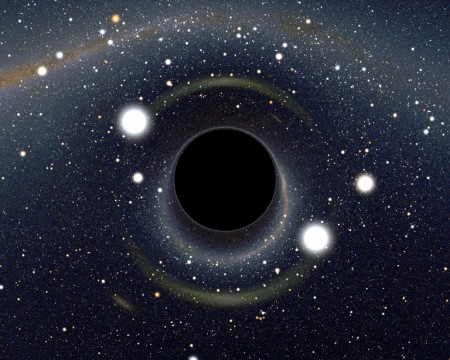
But perhaps the most striking image of the film Interstellar is the one showing a glowing accretion disk which spreads above, below and in front of Gargantua. Accretion disks have been detected in some double-star systems that emit X-ray radiation (with black holes of a few solar masses) and in the centers of numerous galaxies (with black holes whose mass adds up to between one million and several billion solar masses). Due to the lack of spatial resolution (black holes are very far away), no detailed image has yet been taken of an accretion disk ; but the hope of imaging accretion disks around black holes telescopically, using very long baseline interferometry, is nearing reality today via the Event Horizon Telescope[ii]. In the meanwhile, we can use the computer to reconstruct how a black hole surrounded by a disk of gas would look. The images must experience extraordinary optical deformations, due to the deflection of light rays produced by the strong curvature of the space-time in the vicinity of the black hole. General relativity allows the calculation of such an effect.
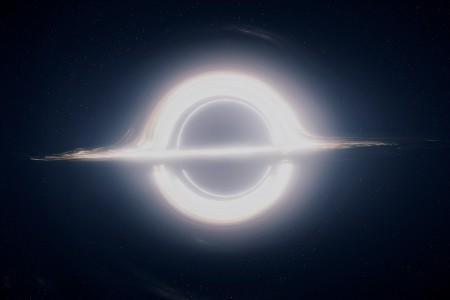
In 1979 I was the first to simulate the black and white appearance of a thin accretion disk gravitationally lensed by a non-spinning black hole, as seen from far away, but close enough to resolve the image[iii]. I took a Schwarzschild black hole and a thin disk of gas viewed from the side, either by a distant observer or a photographic plate. In an ordinary situation, meaning in Euclidean space, the curvature is weak. This is the case for the solar system when one observes the planet Saturn surrounded by its magnificent rings, with a viewpoint situated slightly above the plane. Of course, some part of the rings is hidden behind the planet, but one can mentally reconstruct their elliptic outlines quite easily. Around a black hole, everything behaves differently, because of the optical deformations due to the space-time curvature. Strikingly, we can see the top of the disk in its totality, whatever the angle from which we view it may be. The back part of the disk is not hidden by the black hole, since the images that come from it are to some extent enhanced by the curvature, and reach the distant observer. Much more astonishing, one also sees a part of the bottom of the gaseous disk. In fact, the light rays which normally propagate downwards, in a direction opposite to that of the observer, climb back to the top and furnish a « secondary image », a highly deformed picture of the bottom of the disk (in theory, there is a tertiary image which gives an extremely distorted view of the top after the light rays have completed three half-turns, then an image of order 4 which gives a view of the bottom which is even more squashed, and so on to infinity).
[for more explanations and pictures, see my previous post black hole imaging : head and tails]
Thus, when I saw for the first time the image of the accretion disk in Interstellar, I was not surprised to see the disk spreading above, below and in front of Gargantua’s silhouette. The visual result was awesome, and the team at Double Negative could be proud of that. But when I read in press releases that this image was the first and the more realistic image of a black hole accretion disk ever made, I was puzzled, because basic visual effects were obviously missing.
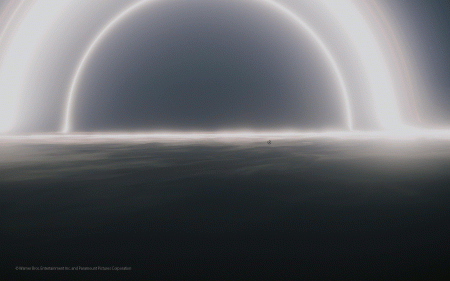
In my 1979 simulation, I had also taken into account the physical properties of the gaseous disk : rotation, temperature and emissivity. In a thin accretion disk, the intensity of radiation emitted from a given point on the disk depends on its distance from the black hole. Therefore the brightness of the disk cannot be uniform, as suggested in Interstellar. The maximum brilliance comes from the inner regions close to the horizon, because it is there that the gas is hottest. In addition, the apparent luminosity of the disk is still very different from its intrinsic luminosity : the radiation picked up at a great distance is frequency- and intensity-shifted with respect to the emitted one. There are two sorts of shift effects. There is the Einstein effect, in which the gravitational field lowers the frequency and decreases the intensity. And there is the better-known Doppler effect, where the displacement of the source with respect to the observer causes amplification as the source approaches and attenuation as the source retreats. In this case, the disk rotating around the black hole causes the Doppler effect. The regions of the disk closest to the black hole rotate at a velocity approaching that of light, so that the Doppler shift is considerable and drastically modifies the image as seen by a faraway observer. The sense of rotation of the disk is such that matter recedes from the observer on, say the right-hand side of the photograph, and approaches on the left-hand side. As the matter recedes, the Doppler deceleration is added to the gravitational deceleration, implying a very strong attenuation on the right-hand side. In contrast, on the left-hand side the two effects tend to cancel each other out, so the image more or less retains its intrinsic intensity. In any case, a realistic image must show a strong asymmetry of the disk’s brightness, so that one side is far brighter and the other is far dimmer.
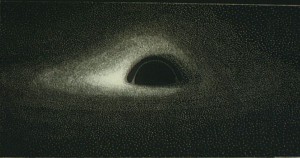
To describe the complete image I obtained (now easily available on the internet[iv]), no caption could fit better than these verses by the French poet Gérard de Nerval, written as soon as in 1854:
In seeking the eye of God, I saw nought but an orbit
Vast, black, and bottomless, from which the night which there lives
Shines on the world and continually thickens
A strange rainbow surrounds this somber well,
Threshold of the ancient chaos whose offspring is shadow,
A spiral engulfing Worlds and Days ![v]
All the above-mentioned effects change also the colors, e.g. from blue on one side to red on the other, and so on. This could not be seen on my black and white (bolometric) image, but my pioneering work motivated visualizations of accretion disks around black holes with ever increasing sophistication. Especially, Fukue and Yokoyama[vi] added colours to the disk ; Viergutz[vii] made the black hole spin and produced coloured images including the disk’s secondary image wrapping under the black hole; Marck[viii] laid the foundations for a nice movie available on the web[ix], with the camera moving around close to the disk, and included higher order images. Sophisticated ray-tracing codes and accretion flow models have been developed recently, including full 3D-simulations of accretion flows and images of these, see for instance Chan et al.[x] for simulating the aspect of the Galactic black hole Sagittarius A*.
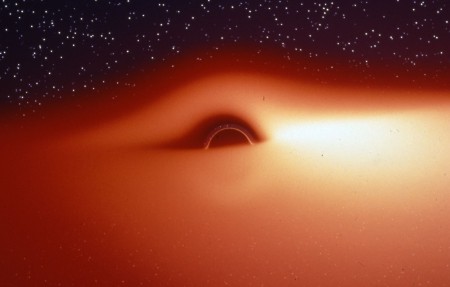
Of course Kip Thorne did not ignore these effects. But, as he wrote me in a spontaneous mail, the film director estimated that a general audience would have been totally baffled by what they are looking at ; so a conscious decision was made to leave out the Einstein and Doppler shifts as well as the physical properties of the disk, and have an accretion disk with the right shape but not the right lopsidedness. As an additional simplification, they have also chosen to apply their calculations to a black hole smaller than Gargantua, and with a much more moderate spin – otherwise the visual effects would have become completely weird and incomprehensible, even for educated physicists ! However, in order to fully exploit their ray-tracing code, in parallel to the movie and the popular nook Thorne and the team at Double Negative have submitted to a peer-review a technical paper[xi] including all the corrections.
TIDAL STRESS
When an object – a planet, a star – moves around a black hole, the forces of gravity act more strongly on the side of the body nearer to the black hole than on the other side. The difference between the two forces is called the tidal force. If the celestial body moves along an approximately circular orbit at a reasonable distance, the tidal forces remain small and the body is able to adjust its internal configuration to the external forces, adopting an elongated shape oriented towards the hole. However, if the body is moving along an eccentric orbit, as the distance r from the black hole decreases the tidal forces increase rapidly (like r-3). Eventually there comes a point where these forces are as large as the forces binding the body together. The planet or the star have no longer time to adjust their internal configuration, begin to deform catastrophically and are inevitably disrupted. This happens rather frequently in the universe.
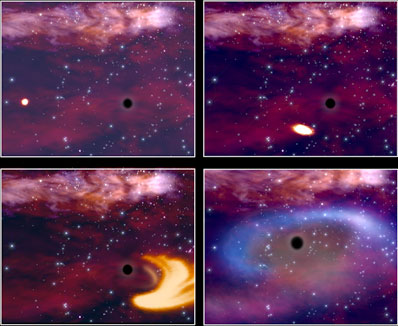
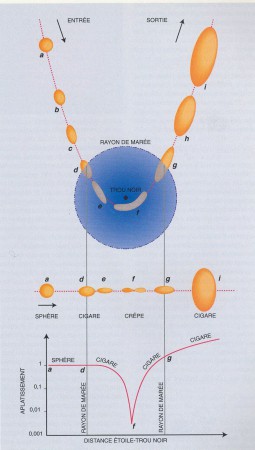
In the 1980’s, I worked a lot on the process of disruption of full stars by massive black holes[xii]. For extreme cases, when the star grazes the event horizon along a parabolic orbit without being swallowed, I predicted the occurrence of « flambéed stellar pancakes », releasing a lot of radiative energy[xiii]. Our telescopes have since captured such scenes. However, these events occur only when the body gets within some critical radius from the black hole, called the Roche limit – after the French mathematician who studied the problem of tidal forces in 1847 in the context of planets and their satellites.
On the Internet, some bloggers have claimed that the Miller’s planet should be completely destroyed by tidal forces, since it is so close to the black hole’s surface. This is not necessarily so, and Interstellar is marginally correct on this point. In effect, the Roche limit depends on the mass of the black hole and on the average density of the external body according to the law RR ~ (M/r*)1/3, where M is the mass of the black hole and r* the density of the body. Applying this formula to the case of Gargantua (M = 108 solar masses) and a water planet (r* ~1 g/cm3) we get RR ~ 1013 cm. Now the gravitational radius of the Gargantua black hole, GM/c2, is also of order 1013 cm. Therefore Miller’s planet must suffer large tidal forces, but not enough to be torn apart (for black holes still more massive than 108 solar masses, such as those suspected to lie in the centers of quasars, the Roche limit becomes significantly smaller than the gravitational radius, and in that case, planets or stars can be broken up by the tidal forces only once they are inside the black hole).
Now, in the movie, once the explorers have « landed » on Miller’s planet – a water one -, they find it suffering periodic and enormous tidal waves sweeping around. These are unexplained, but we can assume they are caused by the tides from the black hole. We would have to solve some equations to find out whether such kilometer high waves are physically realistic. These equations both involve laws of gravity (if their origin is indeed tidal) and hydrodynamics, more precisely the Navier-Stokes theory. From the film, we notice that the wavelength of the water waves is much greater than the depth of the water itself ; such a situation is ripe for the « shallow-water » approximation, which are obtained by applying the Navier-Stokes equations to such a problem. Fluid mechanics textbooks discuss these equations at length ; they are coupled, nonlinear partial differential equations, depending on various parameters such as the surface gravity on the planet g, its rotation rate, the viscous drag forces, and so on.
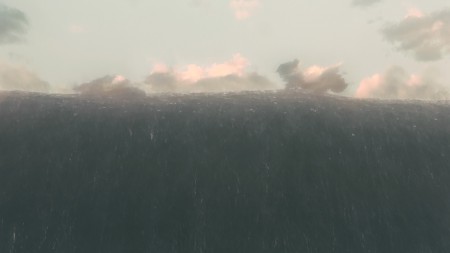
For the situation in Interstellar, we are told that the acceleration due to gravity on the planet is 130% that of Earth’s, which means that g = 9.81 x 1.30 = 12.75 m/s2. The other parameters will be influenced by internal forces in planet’s structure, combined with complex external effects due to the gravitational field of the rotating black hole. There are too many uncertainties on the knowledge of all the parameters to be able to solve numerically the equations.
Nevertheless, I suspect some inconsistency in the film. A tidal wave is actually a bulge of water fixed in space, always oriented in the same configuration, so the astronauts on the planet rotate in and out of that bulge. They feel it as a wave coming towards them and away from them, experiencing from a high tide part of the water to a low tide part of the water. In Interstellar, the waves come every hour or so, which means that the planet rotates once ever two of those (because there are two high tides for every rotation). The problem is that with such huge tides, the planet should become quickly tidally locked with the black hole (i.e., like the Moon to the Earth, always presenting the same face to the black hole). We have formulas telling how fast tidal locking occurs in binary systems. Using a 108 solar masses black hole and a planet with a surface gravity about 13 m/s2, we find that the time scale for tidal locking is only 1 millisecond ! Once the planet is tidally locked to the black hole, it spins only once per revolution, and on top of it water stays in place, always pulled towards the black hole.
References
[i] A. Riazuelo, http://www2.iap.fr/users/riazuelo/interstellar
[ii] Event Horizon Telescope Collaboration website: http://eventhorizontelescope.org
[iii] J-P. Luminet : Image of a spherical black hole with thin accretion disk, Astron. Astrophys. 75, 228 (1979).
[iv] J.-P. Luminet : http://luth2.obspm.fr/~luminet/Books/Nerval.html
[v] G. de Nerval, Le Christ aux Oliviers, in Les Chimères, Paris, 1854. Free translation by J.-P. Luminet.
[vi] J. Fukue and T. Yokoyama : Colour photographs of an accretion disk around a black hole, Publ. Astron. Soc. Japan 40 15 (1988)
[vii] S. U. Viergutz : Image generation in Kerr geometry I. Analytical investigations on the stationary emitter-observer problem, Astron. Astrophys. 272, 355 (1993).
[viii] J.-A. Marck :Short-cut method of solution of geodesic equations for Schwarzschild black hole, Class. Quantum Grav. 13 393402 (1996). See also Marck J.-A. and Luminet J.P. : Plongeon dans un trou noir, Pour la Science Hors-Série « Les trous noirs » (July 1997) 5056.
[ix] J.-A. Marck : https://www.youtube.com/watch?v=5Oqop50ltrM. Conversion into a movie first appeared in the documentary Infinitely Curved by L. Delesalle, M. Lachièze-Rey and J.-P. Luminet, CNRS/Arte, France, 1994.
[x] C.K. Chan et al. (2014) : The Power of Imaging : Constraining the Plasma Properties of GRMHD Simulations Using EHT Observations of SgrA* [arXiv :1410.3492].
[xi] O. James, E. von Tunzelmann, P. Franklin, K. Thorne : Gravitational Lensing by Spinning Black Holes in Astrophysics and in the Movie Interstellar, submitted to Classical and Quantum Gravity (2014)
[xii] J.-P. Luminet & B.Carter : Dynamics of an Affine Star Model in a Black Hole Tidal Field, Astrophys. J. Suppl. 61, 219-248 (1986)
[xiii] B.Carter & J.-P. Luminet : Pancake Detonation of Stars by Black Holes in Galactic Nuclei, Nature 296, 211 (1982)

“no caption could fit better than these verses by the French poet Gérard de Nerval..” – don’t you find it odd that a French poet from the 19th century who did not even had a scientific concept of a black-hole somehow managed to describe one to a T? What does that tell you about “inspired insight” and other “paranormal” things?
Thanks for your reading. I never said that I found this “odd”. 20 years ago I published (in French) a full book on the intuition of poets (or “inspired insight” if you prefer). But no need of “paranormal” !
It is likely irrelevant given the 1 ms tidal locking, but is the tidal locking formula used to generate the 1ms tidal locking period based upon a planet having a solid core as opposed to a planet with a liquid core?
I don’t think it makes a significant difference, in both cases the average density being of the order of 1 g/cc…
9 April 2019
Based on work by Ernest Sternglass (1923-2015), one can predict that, if astronomers are ever able to obtain a photographic image of the massive object at the center of a galaxy, then they will find that it is much LARGER THAN THEY EXPECTED.
With kind regards,
Mark Creek-water Dorazio, Phoenix, Arizona, USA